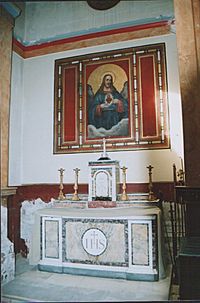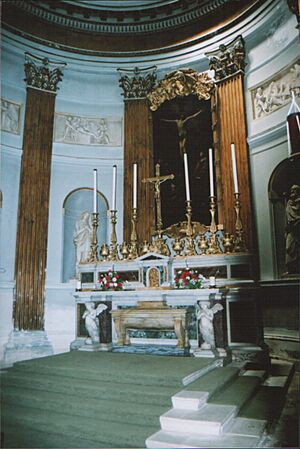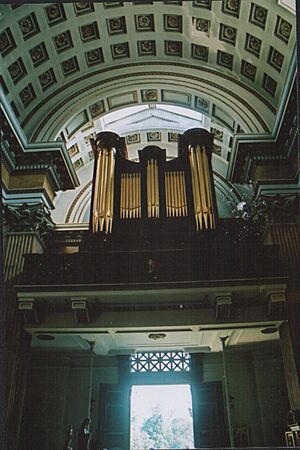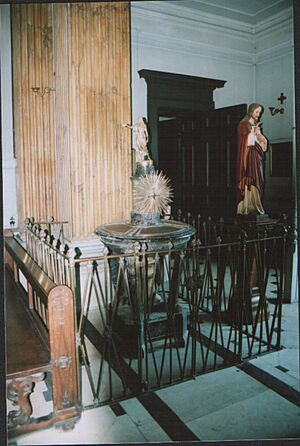- This page was last modified on 17 October 2025, at 10:18. Suggest an edit.
Ss Mary & Everilda, Everingham facts for kids
| Chapel of Ss Mary & Everilda | |
|---|---|

Side Chapel Altar of St. Mary the Virgin and St. Everilda, Everingham
|
|
| Lua error in Module:Location_map at line 420: attempt to index field 'wikibase' (a nil value). | |
| OS grid reference | SE804421 |
| Location | Everingham, East Riding of Yorkshire |
| Country | England |
| Denomination | Roman Catholic |
| History | |
| Former name(s) | private chapel |
| Consecrated | 9 July 1839 |
| Architecture | |
| Functional status | occasional |
| Heritage designation | Grade I listed |
| Architect(s) | Agostino Giorgioli |
| Architectural type | Italianate-style |
| Years built | 1836–1839 |
| Closed | 2004 (as a parish church) |
| Administration | |
| Diocese | Middlesbrough |
| Province | Liverpool |
The Chapel of St. Mary the Virgin and St. Everilda is a beautiful Roman Catholic chapel. You can find it in the small village of Everingham in the East Riding of Yorkshire, England. This chapel is known for its amazing Italianate style. It belongs to the Guest family and is a very important building. It is listed as a Grade I building, which means it has special historical or architectural value. The chapel also has a wonderful organ.
Contents
A Look Back: The Chapel's History
The chapel's grand exterior, made of stucco, stands out next to the red-brick Everingham Hall. The Hall was built between 1757 and 1764 for William Haggerston Constable. It was designed by a famous architect named John Carr.
The chapel itself was built much later, between 1836 and 1839. It was constructed by William Constable-Maxwell, who was a descendant of the Constable family. His family had a long history of being Catholic, even when it was difficult to practice their faith openly. This was before the Roman Catholic Relief Act 1829 was passed. This act made it easier for Catholics to practice their religion in England.
After the act was passed, many Catholic supporters helped build new churches and chapels. Yorkshire, where Everingham is located, had many families who stayed Catholic after the Protestant Reformation. Some villages, like Everingham, were almost entirely Catholic. The Chapel of St. Everilda was built right on the grounds of Everingham Hall.
The chapel was designed in Italy by a young Roman architect named Agostino Giorgioli. John Harper from York oversaw the building work. The design was inspired by a building called the Maison Dieu in Nîmes, France.
The church has tall Corinthian columns inside. These columns support a decorative beam structure and a deeply carved, rounded ceiling. The area around the altar also has matching columns and a cleverly designed half-dome ceiling. You can see impressive statues of the apostles around the main part of the church. There are also statues of Our Lady and St. Everilda near the altar.
The chapel was officially opened and blessed on July 9, 1839. Many important church leaders attended the ceremony, which lasted almost seven hours. A special Mass was held the next day.
Inside the Chapel: Amazing Decorations
While the outside of the chapel looks simple, the inside is truly magnificent. It has a long main hall lined with Corinthian columns. In the walls, there are special spaces called niches. These niches hold life-sized plaster statues of the Apostles. There are also carved pictures, called bas-reliefs, that show scenes from the life of Christ. These were made by Luigi Bozzoni from Carrara, Italy.
The ceiling is shaped like a half-cylinder, known as a barrel vault. It ends in a rounded space behind the altar called an apse. The altar itself is made of marble with polished granite and porphyry stone panels. The chapel also features lots of painted marble effects and real gold leaf, which makes it look even grander. The way sound travels in the chapel is also very special.
The organ in the chapel was made by Charles Allen around the same time the chapel was built. It sits high up in a gallery at the back of the church, under the rounded ceiling. Even though it's not a huge organ, it looks very grand. It has a large mahogany case with a shiny gold front. The biggest pipes of the organ are hidden inside. The main part of the organ is at the front, and a smaller section is behind it. The very bottom of the organ holds a huge air storage tank.
The Chapel Today
The Roman Catholic parish in Everingham officially closed in 2004. However, the chapel is still used by the Diocese of Middlesbrough. Masses are still held there regularly. The Institute of Christ the King Sovereign Priest offered to take care of the church and provide a priest. But this offer was not accepted by the Bishop of Middlesbrough, John Patrick Crowley. This decision caused some discussion, especially since the diocese was looking for more priests at the time.
Cemetery
Next to the chapel, there is a Roman Catholic cemetery. This cemetery is the resting place for many people. It also contains a war grave for a soldier from the East Yorkshire Regiment who fought in the First World War.



